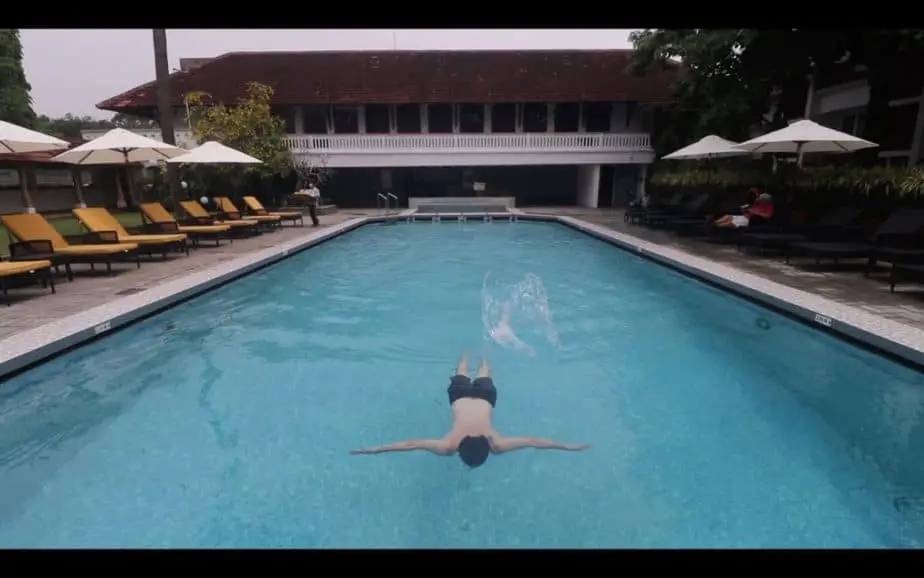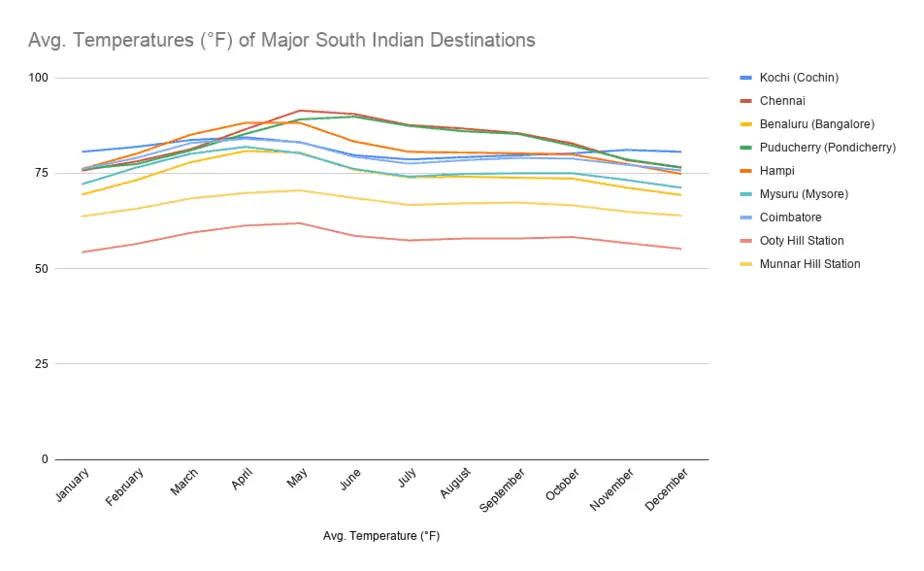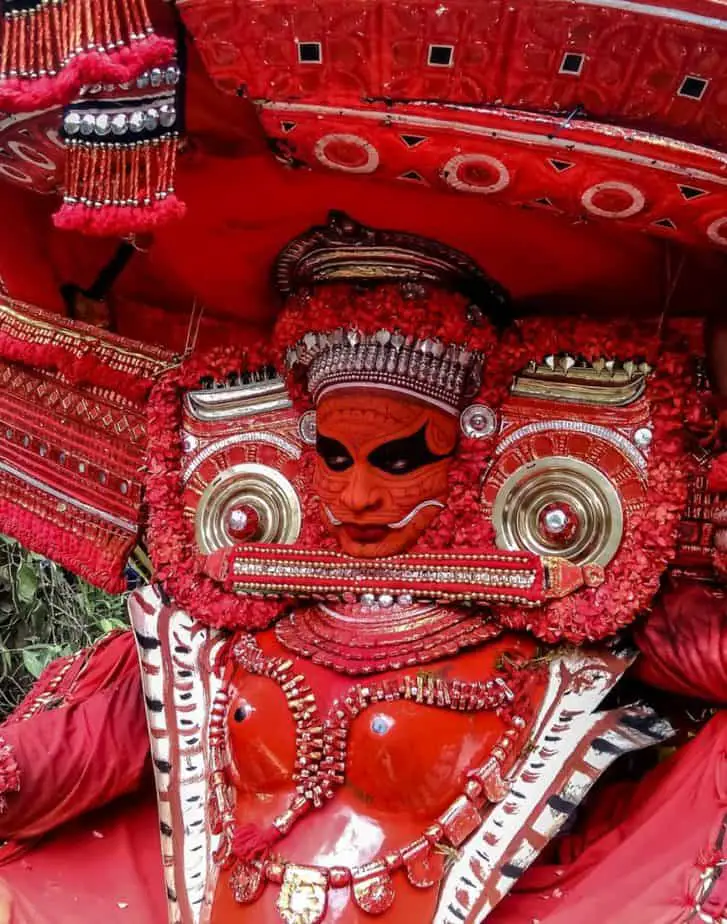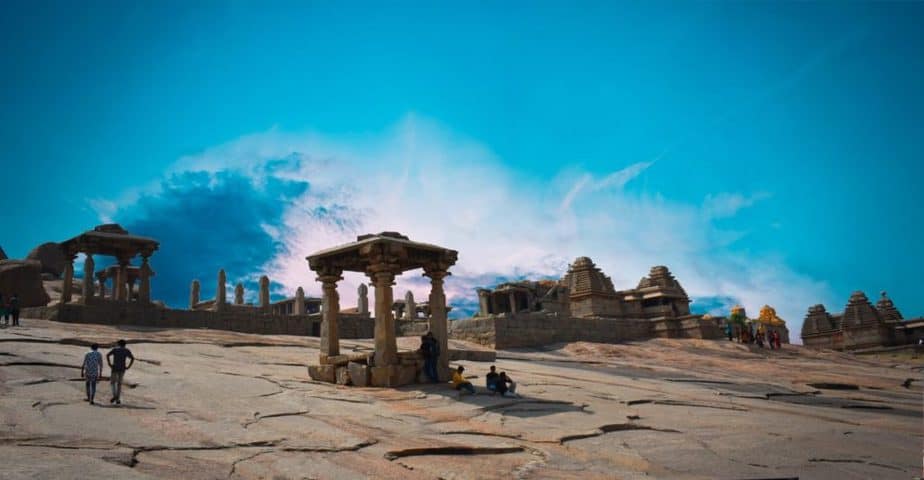
If you’re planning a trip to Kerala, Chennai or another South Indian destination, then it’s smart to figure out when the weather is nice. The summers can be scorchingly hot and you don’t want to get stuck in a monsoon! My family came to India to travel with me, so we did some research and planned our travels when the weather was great.
What is the best time to visit South India for ideal weather? December, January and February have ideal temperatures for sightseeing in major destinations. The temperature averages between 70°F to 81°F (21°C to 27°C). There is also very little rainfall and humidity at this time.
Overview of the weather in major South Indian destinations during December, January, & February:
- Cochin (Kochi) averages 81°F (27°C) with less humidity.
- Chennai averages 77°F (25°C) with little or no rain.
- Bengaluru (Bangalore) averages 70°F (21°C) with little or no rain.
- Puducherry (Pondicherry) averages 77°F (25°C) but gets more rain especially in December.
- Hampi averages 77°F (25°C) with almost no rain.
- Mysuru (Mysore) averages 73°F (22°C) with little or no rain.
- Coimbatore averages 77°F (25°C) with only a little rain.


If you prefer cooler temperatures or are visiting South India during the summer months (April – July), then visit a hill station like Ooty or Munnar.
For the average, maximum, and minimum temperatures for each month, as well as rainfall for each destination… please see the table below [compiled from Climate-Data.org]
| Destination | January | February | March | April | May | June | July | August | September | October | November | December | |
| Kochi (Cochin) | Avg. Temperature (°F) | 80.6 | 81.9 | 83.7 | 84.4 | 83.1 | 79.7 | 78.6 | 79.2 | 79.7 | 80.2 | 81.1 | 80.6 |
| Kochi (Cochin) | Min. Temperature (°F) | 72 | 73.8 | 76.5 | 77.9 | 77.2 | 74.8 | 73.6 | 74.7 | 74.7 | 74.5 | 74.7 | 72.7 |
| Kochi (Cochin) | Max. Temperature (°F) | 89.2 | 90 | 90.9 | 91 | 89.2 | 84.7 | 83.7 | 83.7 | 84.7 | 86.2 | 87.6 | 88.7 |
| Kochi (Cochin) | Avg. Temperature (°C) | 27 | 27.7 | 28.7 | 29.1 | 28.4 | 26.5 | 25.9 | 26.2 | 26.5 | 26.8 | 27.3 | 27 |
| Kochi (Cochin) | Min. Temperature (°C) | 22.2 | 23.2 | 24.7 | 25.5 | 25.1 | 23.8 | 23.1 | 23.7 | 23.7 | 23.6 | 23.7 | 22.6 |
| Kochi (Cochin) | Max. Temperature (°C) | 31.8 | 32.2 | 32.7 | 32.8 | 31.8 | 29.3 | 28.7 | 28.7 | 29.3 | 30.1 | 30.9 | 31.5 |
| Kochi (Cochin) | Precipitation / Rainfall (mm) | 48 | 19 | 33 | 49 | 139 | 386 | 728 | 708 | 375 | 304 | 303 | 162 |
| Chennai | Avg. Temperature (°F) | 75.7 | 78.1 | 81.3 | 86.5 | 91.4 | 90.5 | 87.6 | 86.7 | 85.5 | 82.8 | 78.4 | 76.5 |
| Chennai | Min. Temperature (°F) | 66.9 | 68.2 | 72 | 78.1 | 82 | 81.1 | 79.2 | 78.3 | 77.2 | 75.4 | 72.1 | 69.1 |
| Chennai | Max. Temperature (°F) | 84.7 | 88 | 90.9 | 95 | 100.9 | 100 | 96.1 | 95.2 | 93.9 | 90.1 | 84.9 | 84 |
| Chennai | Avg. Temperature (°C) | 24.3 | 25.6 | 27.4 | 30.3 | 33 | 32.5 | 30.9 | 30.4 | 29.7 | 28.2 | 25.8 | 24.7 |
| Chennai | Min. Temperature (°C) | 19.4 | 20.1 | 22.2 | 25.6 | 27.8 | 27.3 | 26.2 | 25.7 | 25.1 | 24.1 | 22.3 | 20.6 |
| Chennai | Max. Temperature (°C) | 29.3 | 31.1 | 32.7 | 35 | 38.3 | 37.8 | 35.6 | 35.1 | 34.4 | 32.3 | 29.4 | 28.9 |
| Chennai | Precipitation / Rainfall (mm) | 15 | 3 | 2 | 10 | 32 | 56 | 111 | 154 | 121 | 241 | 329 | 123 |
| Benaluru (Bangalore) | Avg. Temperature (°F) | 69.4 | 73.2 | 77.9 | 80.8 | 80.4 | 75.9 | 73.9 | 74.1 | 73.8 | 73.6 | 71.2 | 69.3 |
| Bengaluru (Bangalore) | Min. Temperature (°F) | 57.7 | 60.3 | 64.9 | 69.1 | 69.3 | 66.9 | 66.2 | 66.2 | 65.3 | 65.3 | 62.2 | 59.2 |
| Bengaluru (Bangalore) | Max. Temperature (°F) | 81.3 | 86.2 | 91 | 92.7 | 91.6 | 84.9 | 81.9 | 82 | 82.4 | 82 | 80.2 | 79.3 |
| Benaluru (Bangalore) | Avg. Temperature (°C) | 20.8 | 22.9 | 25.5 | 27.1 | 26.9 | 24.4 | 23.3 | 23.4 | 23.2 | 23.1 | 21.8 | 20.7 |
| Bengaluru (Bangalore) | Min. Temperature (°C) | 14.3 | 15.7 | 18.3 | 20.6 | 20.7 | 19.4 | 19 | 19 | 18.5 | 18.5 | 16.8 | 15.1 |
| Bengaluru (Bangalore) | Max. Temperature (°C) | 27.4 | 30.1 | 32.8 | 33.7 | 33.1 | 29.4 | 27.7 | 27.8 | 28 | 27.8 | 26.8 | 26.3 |
| Bengaluru (Bangalore) | Precipitation / Rainfall (mm) | 1 | 4 | 8 | 36 | 96 | 68 | 98 | 116 | 182 | 150 | 56 | 16 |
| Puducherry (Pondicherry) | Avg. Temperature (°F) | 76.1 | 77.4 | 81 | 85.3 | 89.1 | 89.8 | 87.4 | 86 | 85.3 | 82.2 | 78.6 | 76.5 |
| Puducherry (Pondicherry) | Min. Temperature (°F) | 69.3 | 69.8 | 73.2 | 78.3 | 80.8 | 80.8 | 79 | 77.7 | 77.2 | 75.6 | 72.9 | 70.3 |
| Puducherry (Pondicherry) | Max. Temperature (°F) | 82.9 | 85.1 | 88.7 | 92.3 | 97.5 | 98.8 | 95.9 | 94.5 | 93.4 | 89.1 | 84.6 | 82.6 |
| Puducherry (Pondicherry) | Avg. Temperature (°C) | 24.5 | 25.2 | 27.2 | 29.6 | 31.7 | 32.1 | 30.8 | 30 | 29.6 | 27.9 | 25.9 | 24.7 |
| Puducherry (Pondicherry) | Min. Temperature (°C) | 20.7 | 21 | 22.9 | 25.7 | 27.1 | 27.1 | 26.1 | 25.4 | 25.1 | 24.2 | 22.7 | 21.3 |
| Puducherry (Pondicherry) | Max. Temperature (°C) | 28.3 | 29.5 | 31.5 | 33.5 | 36.4 | 37.1 | 35.5 | 34.7 | 34.1 | 31.7 | 29.2 | 28.1 |
| Puducherry (Pondicherry) | Precipitation / Rainfall (mm) | 32 | 9 | 9 | 18 | 50 | 45 | 82 | 154 | 114 | 229 | 285 | 144 |
| Hampi | Avg. Temperature (°F) | 76.1 | 80.1 | 85.1 | 88.2 | 88.2 | 83.3 | 80.6 | 80.4 | 80.2 | 79.9 | 77.4 | 74.8 |
| Hampi | Min. Temperature (°F) | 64.6 | 67.8 | 72.5 | 76.3 | 76.8 | 75 | 73.9 | 73.2 | 72.5 | 71.4 | 67.8 | 64 |
| Hampi | Max. Temperature (°F) | 87.6 | 92.3 | 97.7 | 100.2 | 99.5 | 91.8 | 87.4 | 87.8 | 88.2 | 88.5 | 86.9 | 85.8 |
| Hampi | Avg. Temperature (°C) | 24.5 | 26.7 | 29.5 | 31.2 | 31.2 | 28.5 | 27 | 26.9 | 26.8 | 26.6 | 25.2 | 23.8 |
| Hampi | Min. Temperature (°C) | 18.1 | 19.9 | 22.5 | 24.6 | 24.9 | 23.9 | 23.3 | 22.9 | 22.5 | 21.9 | 19.9 | 17.8 |
| Hampi | Max. Temperature (°C) | 30.9 | 33.5 | 36.5 | 37.9 | 37.5 | 33.2 | 30.8 | 31 | 31.2 | 31.4 | 30.5 | 29.9 |
| Hampi | Precipitation / Rainfall (mm) | 0 | 0 | 2 | 24 | 58 | 61 | 87 | 90 | 129 | 123 | 25 | 9 |
| Mysuru (Mysore) | Avg. Temperature (°F) | 72.1 | 76.5 | 80.1 | 81.9 | 80.2 | 76.1 | 74.1 | 74.8 | 75 | 75 | 73.2 | 71.2 |
| Mysuru (Mysore) | Min. Temperature (°F) | 61.5 | 64.8 | 68.2 | 70.7 | 70.3 | 68.5 | 67.6 | 67.6 | 66.9 | 67.3 | 65.1 | 61.9 |
| Mysuru (Mysore) | Max. Temperature (°F) | 82.9 | 88.2 | 92.1 | 93 | 90.3 | 83.8 | 80.8 | 82 | 83.3 | 82.9 | 81.5 | 80.8 |
| Mysuru (Mysore) | Avg. Temperature (°C) | 22.3 | 24.7 | 26.7 | 27.7 | 26.8 | 24.5 | 23.4 | 23.8 | 23.9 | 23.9 | 22.9 | 21.8 |
| Mysuru (Mysore) | Min. Temperature (°C) | 16.4 | 18.2 | 20.1 | 21.5 | 21.3 | 20.3 | 19.8 | 19.8 | 19.4 | 19.6 | 18.4 | 16.6 |
| Mysuru (Mysore) | Max. Temperature (°C) | 28.3 | 31.2 | 33.4 | 33.9 | 32.4 | 28.8 | 27.1 | 27.8 | 28.5 | 28.3 | 27.5 | 27.1 |
| Mysuru (Mysore) | Precipitation / Rainfall (mm) | 1 | 2 | 8 | 47 | 127 | 38 | 56 | 38 | 78 | 150 | 44 | 11 |
| Coimbatore | Avg. Temperature (°F) | 76.1 | 79 | 82.9 | 84 | 83.1 | 79.3 | 77.5 | 78.4 | 79 | 78.8 | 77.2 | 75.7 |
| Coimbatore | Min. Temperature (°F) | 66.6 | 68.2 | 71.6 | 73.9 | 74.3 | 72.3 | 71.4 | 71.6 | 71.4 | 71.4 | 69.8 | 67.3 |
| Coimbatore | Max. Temperature (°F) | 85.6 | 90 | 94.3 | 94.1 | 91.9 | 86.5 | 83.8 | 85.3 | 86.7 | 86.2 | 84.6 | 84.2 |
| Coimbatore | Avg. Temperature (°C) | 24.5 | 26.1 | 28.3 | 28.9 | 28.4 | 26.3 | 25.3 | 25.8 | 26.1 | 26 | 25.1 | 24.3 |
| Coimbatore | Min. Temperature (°C) | 19.2 | 20.1 | 22 | 23.3 | 23.5 | 22.4 | 21.9 | 22 | 21.9 | 21.9 | 21 | 19.6 |
| Coimbatore | Max. Temperature (°C) | 29.8 | 32.2 | 34.6 | 34.5 | 33.3 | 30.3 | 28.8 | 29.6 | 30.4 | 30.1 | 29.2 | 29 |
| Coimbatore | Precipitation / Rainfall (mm) | 8 | 9 | 12 | 53 | 75 | 35 | 41 | 30 | 44 | 151 | 121 | 39 |
| Ooty Hill Station | Avg. Temperature (°F) | 54.3 | 56.5 | 59.4 | 61.3 | 61.9 | 58.6 | 57.4 | 57.9 | 57.9 | 58.3 | 56.7 | 55.2 |
| Ooty Hill Station | Min. Temperature (°F) | 41.7 | 44.1 | 47.7 | 51.1 | 52.7 | 52.5 | 52.3 | 52.2 | 51.1 | 50.7 | 47.7 | 43.9 |
| Ooty Hill Station | Max. Temperature (°F) | 67.1 | 68.9 | 71.2 | 71.8 | 71.2 | 64.9 | 62.4 | 63.7 | 64.9 | 65.8 | 65.7 | 66.7 |
| Ooty Hill Station | Avg. Temperature (°C) | 12.4 | 13.6 | 15.2 | 16.3 | 16.6 | 14.8 | 14.1 | 14.4 | 14.4 | 14.6 | 13.7 | 12.9 |
| Ooty Hill Station | Min. Temperature (°C) | 5.4 | 6.7 | 8.7 | 10.6 | 11.5 | 11.4 | 11.3 | 11.2 | 10.6 | 10.4 | 8.7 | 6.6 |
| Ooty Hill Station | Max. Temperature (°C) | 19.5 | 20.5 | 21.8 | 22.1 | 21.8 | 18.3 | 16.9 | 17.6 | 18.3 | 18.8 | 18.7 | 19.3 |
| Ooty Hill Station | Precipitation / Rainfall (mm) | 24 | 20 | 37 | 109 | 161 | 206 | 369 | 264 | 174 | 252 | 162 | 69 |
| Munnar Hill Station | Avg. Temperature (°F) | 63.7 | 65.7 | 68.4 | 69.8 | 70.5 | 68.5 | 66.7 | 67.1 | 67.3 | 66.6 | 64.9 | 63.9 |
| Munnar Hill Station | Min. Temperature (°F) | 55.2 | 56.7 | 59.2 | 61.7 | 63.1 | 62.4 | 61.3 | 61.3 | 60.8 | 60.3 | 58.6 | 56.3 |
| Munnar Hill Station | Max. Temperature (°F) | 72.3 | 74.7 | 77.5 | 78.1 | 78.1 | 74.7 | 72.3 | 73 | 73.8 | 72.9 | 71.2 | 71.4 |
| Munnar Hill Station | Avg. Temperature (°C) | 17.6 | 18.7 | 20.2 | 21 | 21.4 | 20.3 | 19.3 | 19.5 | 19.6 | 19.2 | 18.3 | 17.7 |
| Munnar Hill Station | Min. Temperature (°C) | 12.9 | 13.7 | 15.1 | 16.5 | 17.3 | 16.9 | 16.3 | 16.3 | 16 | 15.7 | 14.8 | 13.5 |
| Munnar Hill Station | Max. Temperature (°C) | 22.4 | 23.7 | 25.3 | 25.6 | 25.6 | 23.7 | 22.4 | 22.8 | 23.2 | 22.7 | 21.8 | 21.9 |
| Munnar Hill Station | Precipitation / Rainfall (mm) | 18 | 29 | 47 | 129 | 189 | 420 | 583 | 364 | 210 | 253 | 164 | 64 |
Maximum, Average & Minimum Temperatures of Major South Indian Destinations
Check the maximum temperatures for the most accurate reading of how hot a place will be. This is the temperature during the afternoon, and when you might want to be sightseeing.
The minimum temperature will tell you how cold it gets during the middle of the night.






Average Rainfall per Month in the Major South Indian Destinations
Places like Kochi (Cochin) get a lot of rain during the monsoon, which makes sightseeing almost impossible. For most places the monsoon starts in June and lasts until September.
Some destinations in South India, like Chennai and Puducherry (Pondicherry), have a monsoon that starts in October and November.

Major Events in South India During The Peak Months: December, January & February
Most tourists visit South India during these winter months, so there are a lot of fun things to do. Here are some cool events I’ve been to or researched that I’d recommend:
December

Cochin Carnival, Kerala.
Thousands of people head to the decorated streets of Fort Kochi for this carnival, which runs for two weeks coming to a climactic end on New Year’s Day. The main attraction is a 35-foot tall statue of Pappanji, an old man loosely resembling Santa Claus. The carnival ends by burning him to the ground to welcome in the New Year. The celebration is rooted in the tradition of the British and Portuguese colonial days.
You can find events like food stalls, arts, games, bike races, shows and elephants dressed up in costume. The people wear colorful clothing, dance and festive music plays through the streets.
Hot Air Balloon Festival, Karnataka.
Throughout the month of December, you can see the beauty of Hampi and Mysuru (Mysore) from between 1000 and 3000 feet up. Hot air ballooning is becoming quite popular in India and this festival is a unique way to see some popular destinations.
The Chennai Music Festival, Tamil Nadu.
This event starts in November and runs for 9 weeks as some of the best professional and amateur Carnatic musicians hold concerts starting in the afternoon and running into the evening. It has been called one of the world’s largest cultural events.
Carnatic music is a historic musical tradition that originated with the Dravidian people from South India and in other parts of Southeast Asia. It is known as one of the most difficult types of music to play and perform. It’s also difficult to enjoy if you’re more used to rock and roll or Drake’s latest album.
It’s a fun and busy event though so it is a good chance to introduce yourself to this beautiful form of music.
Perumthitta Tharavad, Kerala.
This 10-day festival in Kottamkuzhy north of Cochin (Kochi) in Kerala. This festival showcases Theyyam, a centuries-old dance from that comes from the Dravidian tradition as well.
Raji. M and Dr. P. Vennila in A Historical Study of Theyyam define this dance as a “verbal, ritualistic dance performed by well built strong bodied, amply trained artists hailing from the lower state of society.” “Colorful, huge headgears are a unique feature of this dance.” They also say that, “a single definition of the word “Theyyam” might be impossible because it is rather a ritualistic practice continued in the whole of Malabar region.”
This festival doesn’t draw in as many tourists as some of the other events I’ve listed, so if you want a truly Indian experience, this is for you.
Kathrigai Deepam, Tamil Nadu and Kerala.
At the end of November and early December, this 10-day festival to celebrate the triumph of good over evil is observed across in South India. I live in a town 4 hours from Chennai and it’s a big deal here.
The locals haul 2000 liters of clarified butter or ghee up to the top of the holy mountain and light it on fire. It then burns every night for 10 days. On the main day of the celebration, the road is packed with thousands of people doing Girivalam. This a 14-km walk around the mountain often barefoot and often throughout the night. People will also buy new clothes, shave their heads, and light candles.
January

Pongal, Tamil Nadu.
Pongal is a four-day harvest festival in South India, and is one of the most celebrated holidays. Every day you will see beautiful colorful kolams (chalk mandalas) outside of each doorway. Everyone dresses up and celebrates the end of the farming season. At night, families host big dinners and there is dancing.
The festival is named after the food, Pongal, a creamy rice dish that is usually eaten for breakfast. It is flavored with boiled milk and sugar and you can find it in most local restaurants for $0.50 every morning.
For an epic Pongal celebration, head to the International Pongal Festival in Tuticorin. Here you’ll find traditional and modern rock concerts held. There are also sexy dancers eating fire and dressed up elephants as well.
Nishagandhi Dance Festival, Kerala.
Another dance festival in Trivandrum, Kerala lasts for 7 nights and has dance styles from Kuchipudi, Manipuri, Odissi, Bharatanatyam, Kathak, Mohiniyattam, and Chhau. There are also Kathakali performances which is one of the most popular forms of dance in Kerala.
“Kathakali dance-drama is a distinctive genre of South Asian performance which developed during the sixteenth and seventeenth centuries in Malayalam speaking coastal region of south-west India known as Kerala State.”
-Kathakali Dance-Drama: Where Gods and Demons Come to Play. Phillip Zarrilli
The costumes of Kathakali resemble Theyyam but Kathakali means story-play. Also, Theyyam dancers are usually from the lowest castes and they don’t just “act” they actually believe they become the gods as they dance.
Tamil Nadu International Balloon Festival, Tamil Nadu.
If you want to see the Chennai region from the sky, you can go up in a hot air balloon while listening to live music and participating in games. These hot air rides will only go straight up and down, because the balloon is attached to a rope but it’s still beautiful up there.
The cost is around $300 USD (19,999 INR).
Mylapore Festival, Chennai in Tamil Nadu.
Mylapore is just south of Chennai and they hold a kolam contest every January for four days. There are over 100 artists in 30 contests and it’s very competitive.
What is kolam?
Kolam designs of South Indian folk art are treated as examples of two-dimensional picture languages.
-Science Direct. “Array Grammars and Kolam.” By Gift Siromoney & Rani Siromoney, Kamala Krithivasan
Chitra Santhe, Bangalore in Karnataka.
This yearly art fair is held on the first January of each year and has been going on for 17 years. It hosts over 1,500 artists from different states in India with art ranging in price from $1.50 USD to $150 USD. If you’re looking for beautiful and unique souvenirs for family, it’s a great place to buy some!
Swathi Sangeetolsavam, Trivandrum in Kerala.
This free 9-day music festival celebrates the musical compositions of a king of Travancore from the early 19th century. The music is a blend of Carnatic and Hindustani music and many skilled musicians come to play.
Dhaatu International Puppet Festival, Bangalore in Karnataka.
This is great for kids and adults. There are three days of puppet shows which will put to shame any popsicle stick puppet shows you may have had in your home as a kid.
These are serious artists that travel from over five countries to put on an entertaining show.
Mahabalipuram Indian Dance Festival, Chennai in Tamil Nadu.
Mahabalipuram or Mamallapuram is one of the must-see destinations in South India if you want to see beautiful ruins. There are temples and monuments from the 7th and 8th centuries which are visited by 115,000 tourists a year.
Once a year there is also an outdoor dance festival with the iconic temples as a beautiful backdrop. The event lasts for a whole month starting at the end of December with many styles of folk dances being showcased.
Ernakulathappan Uthsavam, Cochin (Kochi) in Kerala.
At the end of January, there is a week-long festival at the Ernakulam Shiva Temple right in the heart of Cochin. The event is meant to show respect and honor for one of the main deities in Hinduism, Lord Shiva.
If you go, you can see the processions of costumed elephants and musicians. You can also buy local handicrafts, see fireworks, and the bathing of the temple gods.
February

Hampi Festival, Karnataka.
The ruins and temples of Hampi are popular with tourists and according to the Hindu received 535,000 tourists in the 2016 – 2017 season. The Hampi Festival or Vijaya Utsav as it’s traditionally called is a cultural event at the end of February showing respect to the once-wealthy city of Hampi (originally called Vijayanagar).
You can find art, dance, music, puppet shows, elephant parades, light shows, and spiritual processions. This festival draws in many foreign tourists and you can find some great souvenirs here.
Thaipooya Mahotsavam, Kerala.
“Harohara” is the rallying cry from the festival-goers at Thaipooya Mahotsavam as an enthusiastic praise to the god, Lord Murugan, the Hindu god of war.
This one-day festival has participants carrying decorations and dancing at the Sree Subrahmanya Swamy Temple. If you like trance dancing or want to pierce your cheek or tongue with the brave locals, then this might be for you.
If you’d prefer a more low-key celebration, you can also find plenty of souvenirs and crafts to purchase. There are also fireworks, music and many celebrations.
Maha Shivratri, across India.
This is another celebration for Lord Shiva, one of the primary gods in Hinduism. This celebration happens across India to show respect to the night when Shiva did the heavenly dance.
I live in a small city in South India and there are parades and performances here because the city and local temple has a lot of Shiva devotees. You can find other Shiva temples in Srisailam, Rameswaram, Thanjavur and more.
Pariyanampetta Pooram Kattakulam, Palakkad in Kerala.
Another spiritual festival in Kerala lasts for 7 days and is centered around the Pariyanampetta Bhagavathy Temple. This is one of the largest Devi temples, and for this celebration, you can find costumed elephant parades, drum lines, and live music shows.
Natyanjali Dance Festival, Tamil Nadu.
Nataraja temples are devoted to Lord Shiva in a dancing pose and can be found around Tamil Nadu. Chidambaram is a popular temple town that is the epicenter of these celebrations where you can find flowers and foods. You can also find dancing in the temples where small groups of women in colorful costumes perform in traditional and modern styles.
One of the most popular celebrations is in Thanjavur, where you can find 10,000 people gathered to join in the Sivaratri pumas while thousands watch them perform.
Other Good Times To Visit South India
Diwali in November
Diwali is a festival of lights, and is one of the most popular festivals in India. It is usually held in November and while Puducherry and Chennai might have heavy rain for the monsoon season, in the other destinations it would be worth a visit.
Fireworks are very popular and the locals will be shooting them off all day. People also give gifts, buy new clothes and sweets, decorate their homes and shops, and pray at the local temples.
August for Independence Day.
On August 15, India became an independent nation and the people are very proud of this day so there are many celebrations. You can find parades, celebrations and kids holding Indian flags across most of the major cities and destinations in South India.
Related Questions:
What is the Best Time To Visit South Indian Temples?
December through February has the best temperatures for visiting the temples in South India. During these months you can find holidays such as Deepam, Maha Shivratri, and other holidays devoted to Shiva temples which are prevalent in South India.
What is the Best Time To Visit Kerala?
January through March has milder temperatures, less humidity, and less rainfall than the rest of the year in Kerala. Many people visit the Backwaters from November to February, but it’s best in January and February because in November the region gets more than 300 mm of rainfall.
When is the Rainy Season in South India?
The monsoon season starts in June and continues through September in most places. Kerala still gets more than 300 mm of rain into November. Pondicherry and Chennai’s monsoon season doesn’t start until July and is heaviest in November.
What is the Best Time To Visit Goa?
November through February is the ideal time to visit Goa for the best weather. Over 400,000 foreign tourists visit Goa each year and most come during this time. For a time with fewer crowds and quieter beaches, October or March are great times.
What is the Best Time To Visit Tamil Nadu?
December through March are the best times to visit Tamil Nadu. November still gets a lot of rain since the monsoon comes later here. March is starting to get hot as the high temperatures climb over 90°F (+30°C) but the tourists leave and it is still cool in the morning and evening.
What is the Best Time To Visit North India?
February and March, as well as October and November, have ideal temperatures in North India without much rain. December and January can get cold. If you go to the Himalayas or destinations like Manali, then you should only go between March and May when it’s the summertime.

